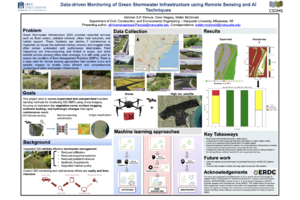2025 CSDMS meeting-135: Difference between revisions
From CSDMS
Created page with "{{CSDMS meeting personal information template-2025 |CSDMS meeting first name=Abhiram Siva Prasad |CSDMS meeting last name=Pamula |CSDMS meeting institute=Marquette University |CSDMS meeting city=Milwaukee |CSDMS meeting country=United States |CSDMS meeting state=Wisconsin |CSDMS meeting email address=abhiramsivaprasad.pamula@marquette.edu }} {{CSDMS meeting select clinics1 2025 |CSDMS_meeting_select_clinics1_2025=4) Get lazy with LLMs }} {{CSDMS meeting select clinics2 2..." |
No edit summary |
||
| (One intermediate revision by one other user not shown) | |||
| Line 47: | Line 47: | ||
{{CSDMS meeting abstract template 2025 | {{CSDMS meeting abstract template 2025 | ||
|CSDMS meeting abstract=Green Stormwater Infrastructure (GSI) plays a critical role in mitigating urban runoff, enhancing water quality, and promoting sustainable stormwater management. To ensure the long-term efficiency of these benefits, effective monitoring and maintenance of GSI is essential; however, current monitoring approaches are limited by costly and time-intensive in-person inspections. This study seeks to directly address these limitations through the integration of remote sensing and machine learning techniques to develop scalable, cost-effective monitoring solutions for GSI. To do so, we present a case study that utilizes high-resolution satellite (<30 cm) and drone imagery (2-4 cm) collected at GSI locations in Milwaukee, WI to extract key maintenance indicators such as vegetation health, sediment, and trash accumulation. Advanced machine learning (both supervised and unsupervised) algorithms, are employed to detect anomalies, assess performance, and automate condition assessment across GSI sites. The developed tools provide near-real-time insights for water resource managers, enabling proactive maintenance and data-driven decision making. This research demonstrates the potential of remote sensing and geospatial technologies to transform GSI monitoring practices and support resilient urban stormwater systems. | |CSDMS meeting abstract=Green Stormwater Infrastructure (GSI) plays a critical role in mitigating urban runoff, enhancing water quality, and promoting sustainable stormwater management. To ensure the long-term efficiency of these benefits, effective monitoring and maintenance of GSI is essential; however, current monitoring approaches are limited by costly and time-intensive in-person inspections. This study seeks to directly address these limitations through the integration of remote sensing and machine learning techniques to develop scalable, cost-effective monitoring solutions for GSI. To do so, we present a case study that utilizes high-resolution satellite (<30 cm) and drone imagery (2-4 cm) collected at GSI locations in Milwaukee, WI to extract key maintenance indicators such as vegetation health, sediment, and trash accumulation. Advanced machine learning (both supervised and unsupervised) algorithms, are employed to detect anomalies, assess performance, and automate condition assessment across GSI sites. The developed tools provide near-real-time insights for water resource managers, enabling proactive maintenance and data-driven decision making. This research demonstrates the potential of remote sensing and geospatial technologies to transform GSI monitoring practices and support resilient urban stormwater systems. | ||
Keywords: Remote sensing, machine learning, near-real-time monitoring, green stormwater infrastructure | |||
|CSDMS meeting posterPDF= Poster_CSDMS_36X24_Abhiramp1.pdf | |||
|CSDMS meeting posterPNG= Poster_CSDMS_36X24_Abhiramp1.png | |||
}} | }} | ||
{{blank line template}} | {{blank line template}} | ||
Latest revision as of 06:18, 27 May 2025
(if you haven't already)
Log in (or create account for non-CSDMS members)
Forgot username? Search or email:CSDMSweb@colorado.edu
Browse abstracts
Data-driven Monitoring of Green Stormwater Infrastructure using Remote Sensing and AI Techniques
Abhiram Siva Prasad Pamula,
Marquette University Milwaukee Wisconsin, United States. abhiramsivaprasad.pamula@marquette.edu
Omar Hegazy, Marquette University Milwaukee Wisconsin, United States. omar.hegazy@marquette.edu
Walter McDonald, Marquette University Milwaukee Wisconsin, United States. walter.mcdonald@marquette.edu
Green Stormwater Infrastructure (GSI) plays a critical role in mitigating urban runoff, enhancing water quality, and promoting sustainable stormwater management. To ensure the long-term efficiency of these benefits, effective monitoring and maintenance of GSI is essential; however, current monitoring approaches are limited by costly and time-intensive in-person inspections. This study seeks to directly address these limitations through the integration of remote sensing and machine learning techniques to develop scalable, cost-effective monitoring solutions for GSI. To do so, we present a case study that utilizes high-resolution satellite (<30 cm) and drone imagery (2-4 cm) collected at GSI locations in Milwaukee, WI to extract key maintenance indicators such as vegetation health, sediment, and trash accumulation. Advanced machine learning (both supervised and unsupervised) algorithms, are employed to detect anomalies, assess performance, and automate condition assessment across GSI sites. The developed tools provide near-real-time insights for water resource managers, enabling proactive maintenance and data-driven decision making. This research demonstrates the potential of remote sensing and geospatial technologies to transform GSI monitoring practices and support resilient urban stormwater systems.
Keywords: Remote sensing, machine learning, near-real-time monitoring, green stormwater infrastructure

